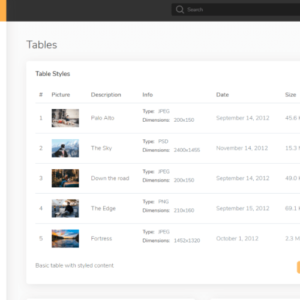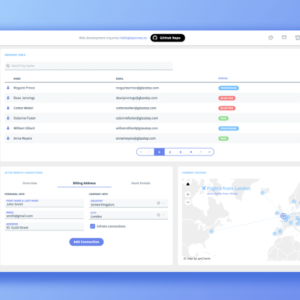Home
Javascript Tutorial
What is JavaScript?
JavaScript is a language of programming that is responsible for providing more interactivity and dynamism to web pages. When JavaScript runs in the browser, you don’t need to use a compiler. The browser reads the code directly, without the need for third parties. Therefore, it is recognized as one of the three mother tongues of the web together with HTML (content and its structure) and CSS (content design and its structure).
Now, JavaScript is not the same as Java, which is a very different programming language. The confusion comes from the name, registered by the same company that created Java (Sun Microsystems). JavaScript (JS) was created later, and what the North American company did was simply change the name that its creators had given it when buying the project (LiveScript). The Java programming language has been focused on much more than just the web since its inception.
The history of JavaScript
The history of JavaScript begins in the early 1990s when users reach the Internet and access the Web thanks to browsers. The connections between the users and the webs are made through very slow lines. When the user wants to send information to the server, if it is incorrect, it takes a while to know … and he loses the information.
Programmers try to get validations in the browser and thus always have positive posts and minimize the loss of information. This was one of the first motivations to create JS, to validate the forms. Programmer Brendan Eich begins putting server tasks into the browser in a new version of Netscape Navigator 2.0 (from the year 95). This task became more and more ambitious and was called LiveScript. When Sun Microsystems later bought Netscape, he named it JavaScript, much like the name of the server-side language (Java) that has absolutely nothing to do with it.
The relationship between JavaScript and Java is purely commercial, there is no relationship at the programming level, they have nothing to do with it. Simply, the confusion arises from the purchase of the Java creators of the Netscape browser.
Client-Side JavaScript
With this programming language on the client-side (not on the server), we can create effects and animations without any interaction, or responding to events caused by the user, such as pressed buttons and modifications of the document object model (DOM). Therefore, it has nothing to do with the Java programming language, since its main function is to help create dynamic web pages.
The JavaScript programming code runs in browsers, whether desktop or mobile, whether Android or iPhone. It works for the same thing, no matter what type of device the browser is running on.
JavaScript is capable of detecting errors in forms, creating beautiful sliders that adapt to any screen, doing mathematical calculations efficiently, of modifying elements of a web page easily. But JS is also responsible for the existence of tools such as Google Analytics, Google Tag Manager, Facebook Pixel and many others, which are clear examples of JavaScript.
There is a technology called AJAX that allows information to be exchanged with the server that does not need to reload the page. That is, we only load what is necessary from the page. This technology developed in JavaScript has been one of the main advances in web development. Although we do not know how to recognize it, it is responsible for us to get more messages, tweets, emails … just by pressing a button, without the need to reload.
JavaScript is the most popular language right now. In fact, for years a version has been created that is capable of being executed also on the server-side (Node JS). Therefore, JavaScript is running right now in browsers and servers, creating around it a vast community of almost full-stack developers. Server-side JavaScript competes on a level playing field with PHP, for example.
Like almost any programming language, we can do object-oriented programming in JavaScript. Without a doubt, how objects are created, modified and displayed in the browser has been one of the great causes of its rise.
Currently, there are some practices, not highly recommended by SEOs, where JS takes care of many style functions. For example, many WordPress themes and plugins use scripts to make web design responsive. Modern browsers interpret this without problems, but the Google spider may think that it is not the best way to do it.
The most widely used JavaScript library in history, and one that is still in use today, is jQuery. With jQuery we could do more, writing less. With a much simpler syntax, we could modify our website, create plugins, animate video games and much more. Currently, jquery has lost space in favour of other more model technologies like React or Angular.
Right at this moment, the Browser Wars begins, where everyone begins to have their own version of LiveScript, like Microsoft (JScript) that was not supported. The beginning of the end of the war occurred in 1997 when the ECMAScript standard was created by several companies. However, Internet Explorer begins to empower your browser with JavaScript, to apply it to games, to improve the user experience, to facilitate the tasks of programmers … but outside the standard.
However, to make this compatibility task easier, libraries such as jQuery and others very similar have emerged. The jQuery library allowed JavaScript to be programmed in a simple and compatible way for all browsers. Little by little, all browsers adopted the standard (Internet Explorer, mainly) and JavaScript became a programming language compatible with all browsers, and the need to use jQuery was less.
Later, JavaScript began to be used on the server-side (NodeJS) as a substitute for other languages ​​such as Java or PHP. To this day, much progress is still being made in this technology.
Advantages of JavaScript
JavaScript is simple to learn:
JavaScript is not a difficult program to control since its learning trajectory is low. Similarly, if you are a user with programming experience, you will understand that the syntax is pretty comparable to different development programs such as C also Java. In extension, it has united communities, where you can gain knowledge such as manuals, tutorials, also codes available to implement.
It’s quite helpful
JavaScript is an official language in the network business, consequently, it can be combined with different technologies. For this purpose, the code may be implanted in every page despite the file size, that is, add scripts in PHP, JPS Perl files, to mention a few.
Server load:
Loading of the web page server is reduced since the program runs on the client-side. Therefore, your site will answer quicker and users will receive it.
Create dynamic interfaces:
t is another notable advantage, with JavaScript it is possible to develop elements like buttons, drop-down menus, surveys, registration forms, change the font colour, add effects to text, etc.
Javascript is multiplatform:
JavaScript runs in different operating systems such as Windows, Linux and Mac. Consequently, any application can be developed and works without problems. Also, it is compatible with today’s modern devices like Smartphones and iPhones.
It’s compatible with different CMS:
If you own a network portal formed in Drupal, Joomla or WordPress you can quickly attach JavaScript scripts to give extra interactivity to your website.
Updates frequently:
Because of the adaptability of the language, corporations like Google, Microsoft has produced frameworks attaching the controller view model, this makes it easy to build web applications in a short time. This evolution allows you to run programs both on the server-side and on the computer, therefore, you can program freely.
Why to Learn JavaScript
Well, previously we analysed some of the advantages that using JavaScript has. But, why should you learn to use it? Here are some clear reasons:
- It’s free!
If you want to begin your quest to mastering JavaScript as soon as possible, there is great news for you. You can get started right now. No unnecessary installations with JavaScript are required. The only thing you need is your internet browser and a trusted code editor.
- It is practically everywhere.
JavaScript is universally recognized. It is also woven into the foundation of programming. You find it everywhere; even without noticing it. JavaScript is now on every platform imaginable: browsers, desktop and mobile apps, devices and more.
- It’s for newbies.
Yet those that have never gotten their hands on programming can be JavaScript masters. Its syntax is very direct and easy to digest that it may be understood by amateurs in no time.
- It works through a great foundational language.
If you want to investigate more complex programming languages, JavaScript is the ideal place. Once you learn it on a more profound level, learning additional languages ​​will be an easy task to achieve.
- It is fun and interactive.
Since JavaScript is used heavily within front-end development, people can play around with graphical interfaces any way they like. They can control animation, design nice user interfaces, build games, etc. The chances are unlimited.
- Is powerful.
Netflix, Paypal, Linkedin and so on, all have in common that are run in JavaScript. Most of the world’s leading apps and also websites use JavaScript in one form or another.
It is moderately simple to diagnose.
Contrary to different languages, JavaScript has a fast feedback circuit. Because it is built in the browser, you can operate your code also getting results instantly. With that method, you’ll be able to learn and improve much faster.
There stands a great demand for JavaScript professionals.
As more and more companies go digital, there is a high demand for people who are trained to grow in JavaScript. And as the programming communication proceeds, investment in JavaScript developers keeps on growing well.
It is a career where you can earn a decent amount of money
JavaScript programmers earn an average of $ 74,000 to $ 130,000 in countries like the United States. So considering the other factors mentioned. Mastering JavaScript is not difficult. It is required in many jobs and the salaries pay off.
It is evolving rapidly.
The JavaScript system keeps evolving. , which means that there is an infinite opportunity for growth.
Javascript courses
“Hello World” using JavaScript
For all those people who enter the world of programming or have a first contact with it, our first great achievement is to print a “Hello World!” or “Hello World!” on our screen. This can be defined as the first program of any developer and we even continue to use it as the initial test of any new project. The “Hello World” or “Hello World” program is considered the simplest in almost all programming languages. It is generally used to show the syntax of a programming language in a simple example and to introduce programmers to that language.
In JavaScript, we will create a document using any text editor, such as notepad, in which we will create a document called test.html and we will add the following code:
<!DOCTYPE HTML>
<html>
<body>
<p>...some text before...</p>
<script>
alert( 'Hello, world!' );
</script>
<p>...some text after the script.</p>
</body>
</html>or
<script type = "text / javascript">
document.write ('Hello World!');
</script>
Then we open this document in our browser and we will get our famous “Hello World” printed on its screen.
Useful JavaScript frameworks and libraries
Libraries vs. framework:
First, you need to highlight their differences. Library and framework are often mistakenly used synonymously. Although the transmission is smooth in many respects, there are substantial differences between the two. Program libraries always host applets that make programming easier thanks to their help functions. Unlike a framework, a library is developed to be used in a certain way and has, for this, functions that have been adjusted to each other.
Another difference between a framework and a library is its control. In the case of libraries, the programmers’ code is accessed through the programming interface of a software. However, frameworks carry out an inversion of control (“Inversion of Control”): the code is integrated into fixed structures of the framework and is displayed when required. In summary, it can be said that the libraries are requested by the program, while the frameworks create the guidelines for the program. Here’s a list of some of the best:
JavaScript Libraries
- jQuery
- Underscore and Lodash
- D3.js
- React
- Glimmer.js
JavaScript Frameworks
- Bootstrap
- Angular and AngularJS
- Ember.js
- Aurelia
- Vue.js





